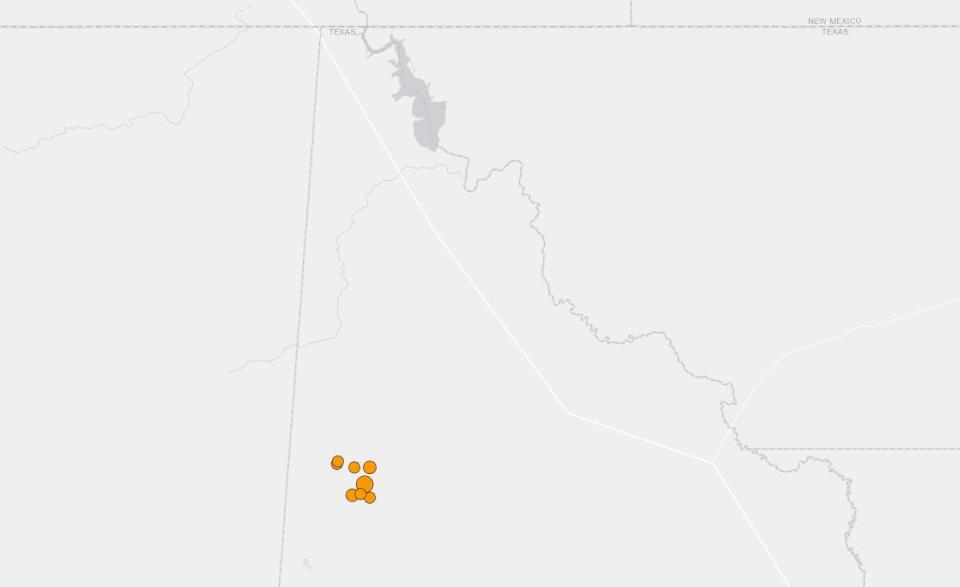Southeast New Mexico shook by early morning earthquake reported in West Texas oilfield
A cluster of earthquakes struck in the early hours of Wednesday morning along the border of southeast New Mexico and West Texas, felt as far east as San Antonio and as far west as El Paso.
Reports of the earthquake being felt also came from Sandia Park near Albuquerque, according to reports from the U.S. Geological Survey (USGS).
It started with a magnitude 5.3 earthquake reported at about 3:27 a.m. near Mentone, Texas, according to the USGS, followed by several smaller quakes nearby.
More: Shaky Ground: The link between the Permian Basin's fossil fuel industry and earthquakes
Eddy County Emergency Manager Jennifer Armendariz said her office received several calls from concerned residents in the minutes and hours after the earthquakes.
She said no damage was reported as of about 9:30 a.m. Wednesday, but that her office would continue to monitor and document subsequent quakes as they happen.
“I believe it was in Pecos (Texas), but it was felt by many residents in Carlsbad from the north end to the south end of town toward Loving,” she said. “Ultimately, I think they’re surprised they’re feeling it in our areas. We get them (seismic events) every day, but they’re typically smaller.”

More: Fault lines at Texas-New Mexico border complicate earthquakes linked to waste water disposal
She asked anyone who feels any ground shaking that could be an earthquake to report the event, and that Eddy County Emergency Management coordinates with the USGS to monitor seismicity in the area.
The incident sparked social media activity in the Carlsbad community, with users reporting they were awakened by the shaking and asking if others felt it.
“Did anyone else feel that strong earthquake just now it shock (sic) my house for 5 seconds,” posted user Frank Methola of Carlsbad on Facebook.
More: Oil and gas is 'deforming' New Mexico's land, study says, as drilling set to grow
“Woke me up,” wrote user Carlsbad resident Larry Campbell on Facebook, along with a post including information on the quake.
Another Facebook user Sharon Funk of Carlsbad posted her “new house really shook for a few seconds.”
Tate Shugart of Carlsbad posted a map of the earthquake and wrote “That was an earthquake..no you’re not tripping lol.”
More: Industry, regulator cooperation dampened Oklahoma's quaking issues over time
At 3:30 a.m. an M 3.2 earthquake was also reported in the area, followed by an M 3.4 at 3:31 a.m. and several M 2.5 events or greater between then and 3:57 a.m., the USGS reported.
The M 5.3 was the biggest earthquake reported in the area since an M 5.3 hit the area Nov. 8, 2022, and an M 5.4 on Nov. 16, 2022.
An M 5.2 was reported Dec. 16 in Range Hill, Texas near Midland, Texas on the eastern side of the Permian.
More: Global report warns of climate crisis from oil, gas pollution. What is New Mexico's role?
There were 1,729 earthquakes at M 2 or greater reported so far this year in the Permian Basin, according to USGS data, while 2,253 quakes were reported in 2022.
Last year marked an increase from 1,631 M 2 or greater earthquakes reported in the basin in 2021.
Permian Basin earthquakes tied to oil and gas
The growing seismicity in the Permian Basin, both in New Mexico and Texas, was tied to growing oil production in the region and the subsequent disposal of wastewater via injection wells.
More: New Mexico researchers report contamination, nuclear material in oil and gas wastewater
The wells pump fluid by products of oil drilling, known as produced water, back into the underground shale formation they are drawn from along side oil and gas.
This practice was believed to stimulate underground fault lines, activating ancient underground rock in the previously seismically inactive area.
In response, the State of New Mexico enacted a series of regulations to limit, or shut-in disposal wells based on their proximity to earthquakes and the magnitude of the events.
More: Can smaller tremors protect New Mexico from oil and gas earthquakes in Permian Basin?
Research published in the Journal of Geophysical Research: Solid Earth said the “induced seismicity” in the Permian Basin dated back to the 1920s when oil and gas production began in the region, with quakes in southern New Mexico linked to wastewater disposal since the 1990s.
The “vast majority” of the quakes in the western Delaware sub-basin of the Permian, around Pecos, Texas about an hour south of Carlsbad, were related to water disposal, the study read.
“Since hydrocarbon production began in the 1920s, the majority of earthquakes in the Permian Basin, located in western Texas and southeastern New Mexico, are likely induced,” read the report.
Adrian Hedden can be reached at 575-628-5516, achedden@currentargus.com or @AdrianHedden on X, formerly known as Twitter.
This article originally appeared on Carlsbad Current-Argus: Southern NM shook by earthquake reported in West Texas oilfield

